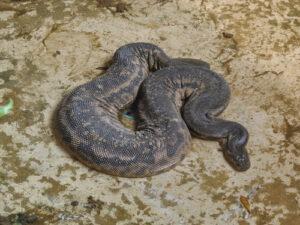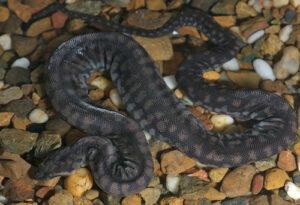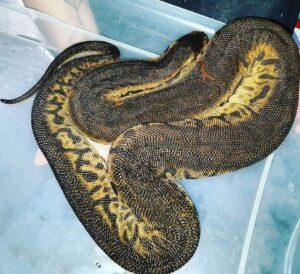The elephant trunk snake or Javan file snake is a species of primitive aquatic snakes with loose, baggy, and wrinkly skin that make them look like elephant trunks. The muscular, nocturnal carnivore can stay underwater for as long as 40 minutes at a stretch surfacing only to breathe in air for 15-20 seconds.
Scientific Classifications
- Suborder:Serpentes
- Family:Acrochordidae
- Genus:Acrochordus
- Species:A. javanicus
Conservation Status
Description
Size
A full-size elephant trunk snake can reach a maximum length of 9.4 inches (2.4 m).
Color and Appearance
The snake’s dorsal side is brown, and its ventral side pale yellow. The loose and baggy skin, covered with small, rough adjacent scales, gives the impression of being much larger than the animal. It has no ventral scales, and the top of the head is covered with small granular scales. There are a total of 120 rows of scales in its stout body. The prehensile tail is short. The flat and broad head looks like that of a boa but it is only as wide as its body. The nostrils are placed atop its snout.
Are They Dangerous to Humans
The snake is very shy and rarely aggressive. But when provoked, it may inflict grievous injuries, albeit being non-venomous. Its teeth often remain stuck to the victim’s flesh when it bites, creating a painful wound.
As a pet, the snake dislikes any form of human interaction, noise, movement, and too much light. It is prone to stress and can’t be handled. So it’s very difficult to acclimatize it to a domestic environment.
Elephant Trunk Snakes at a Glance
Distribution
It is found in southeast Asia – the west coast of the Malaysian peninsula, southern Thailand, Borneo (Sarawak, Kalimantan), and a number of Indonesian islands like Java and Sumatra.
Habitat
They live in coastal regions like estuaries, lagoons, and rivers, preferring freshwater and brackish areas.
Its body is fully adapted to live underwater and can’t support its weight outside water. So leaving water can seriously injure it.
Lifespan
The average lifespan of the Javan file snake in the wild is 5 years. In captivity, the same is 12-15 years.
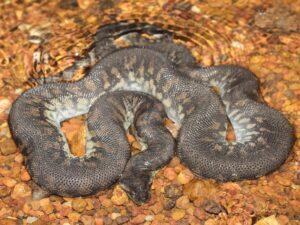
Predators
It has no natural predators.Humans are their primary threat as they kill them for their meat and skin.
Diet
The ambush predator feeds on amphibians and fishes. It catches them by folding its body around the prey and preventing its escape with its loose skin and sharp scales.
Reproduction
Ovoviviparous (gives birth to live young from eggs that hatch inside the body)
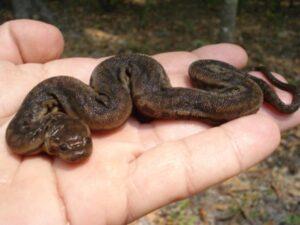
The incubation lasts for 5-6 months for this snake, with the females giving birth to 6-17 young at a time.
Care Sheet
It is challenging to keep this snake as a pet, and caretakers need advanced experience.
Size of the Enclosure: Smaller specimens up to 20 inches can be kept in 10-15 gallon tanks. The larger ones require a tank size of up to 150 gallons or even more. The enclosure should have ample hiding places and a secure lid since the snake tries to escape. The water of pH 5-7 should fill up half of the aquarium.
Substrate: A soft sand and gravel substrate best replicates its natural habitat, but it is not necessary as it’s very tough to clean.
Source
amazonaws.com, reptilesmagazine.com, everythingreptiles.com, scontent.fccu2-1.fna.fbcdn.net, i.pinimg.com

